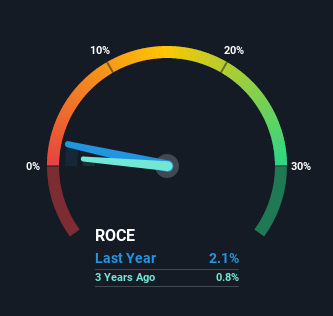- India
- /
- Electric Utilities
- /
- NSEI:DPSCLTD
India Power (NSE:DPSCLTD) Might Have The Makings Of A Multi-Bagger
If you're looking for a multi-bagger, there's a few things to keep an eye out for. Firstly, we'd want to identify a growing return on capital employed (ROCE) and then alongside that, an ever-increasing base of capital employed. This shows us that it's a compounding machine, able to continually reinvest its earnings back into the business and generate higher returns. So when we looked at India Power (NSE:DPSCLTD) and its trend of ROCE, we really liked what we saw.
What is Return On Capital Employed (ROCE)?
For those that aren't sure what ROCE is, it measures the amount of pre-tax profits a company can generate from the capital employed in its business. The formula for this calculation on India Power is:
Return on Capital Employed = Earnings Before Interest and Tax (EBIT) ÷ (Total Assets - Current Liabilities)
0.021 = ₹442m ÷ (₹25b - ₹3.7b) (Based on the trailing twelve months to June 2021).
Therefore, India Power has an ROCE of 2.1%. Ultimately, that's a low return and it under-performs the Electric Utilities industry average of 7.3%.
Check out our latest analysis for India Power

Historical performance is a great place to start when researching a stock so above you can see the gauge for India Power's ROCE against it's prior returns. If you'd like to look at how India Power has performed in the past in other metrics, you can view this free graph of past earnings, revenue and cash flow.
The Trend Of ROCE
While the ROCE is still rather low for India Power, we're glad to see it heading in the right direction. We found that the returns on capital employed over the last five years have risen by 62%. That's a very favorable trend because this means that the company is earning more per dollar of capital that's being employed. Interestingly, the business may be becoming more efficient because it's applying 44% less capital than it was five years ago. A business that's shrinking its asset base like this isn't usually typical of a soon to be multi-bagger company.
What We Can Learn From India Power's ROCE
From what we've seen above, India Power has managed to increase it's returns on capital all the while reducing it's capital base. And since the stock has fallen 58% over the last five years, there might be an opportunity here. So researching this company further and determining whether or not these trends will continue seems justified.
One more thing: We've identified 2 warning signs with India Power (at least 1 which doesn't sit too well with us) , and understanding these would certainly be useful.
For those who like to invest in solid companies, check out this free list of companies with solid balance sheets and high returns on equity.
New: AI Stock Screener & Alerts
Our new AI Stock Screener scans the market every day to uncover opportunities.
• Dividend Powerhouses (3%+ Yield)
• Undervalued Small Caps with Insider Buying
• High growth Tech and AI Companies
Or build your own from over 50 metrics.
Have feedback on this article? Concerned about the content? Get in touch with us directly. Alternatively, email editorial-team (at) simplywallst.com.
This article by Simply Wall St is general in nature. We provide commentary based on historical data and analyst forecasts only using an unbiased methodology and our articles are not intended to be financial advice. It does not constitute a recommendation to buy or sell any stock, and does not take account of your objectives, or your financial situation. We aim to bring you long-term focused analysis driven by fundamental data. Note that our analysis may not factor in the latest price-sensitive company announcements or qualitative material. Simply Wall St has no position in any stocks mentioned.
About NSEI:DPSCLTD
India Power
Engages in the generation and distribution of electricity in India.
Adequate balance sheet average dividend payer.
Similar Companies
Market Insights
Community Narratives



